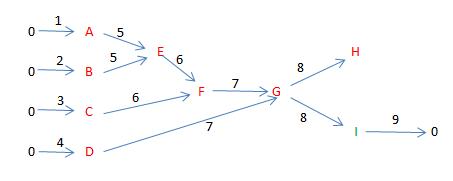This page is a part of the Computer Vision Wiki. The wiki is devoted to computer vision, especially low level computer vision, digital image analysis, and applications. The exposition is geared towards software developers, especially beginners. The wiki contains discussions, mathematics, algorithms, code snippets, source code, and compiled software. Everybody is welcome to contribute with this in mind - all links are no-follow.
Adding Pixels
From Computer Vision Wiki
Generally, adding a new vertex creates a new component and a new node in the graph. Adding a new edge either connects two components or creates a hole in an existing component. Adding the cell itself eliminates a 1-cycle.
Now, let's consider the step of adding a single pixel to a black image. The pixel consists of 9 parts numbered as follows:
- vertices 1-4,
- edges 5-8,
- pixel itself 9.
They are added in this order illustrated below.
- Stage 1: 4 vertices (1-4) are added and exist as separate 0-cycles, A, B, C, D.
- Stage 2: as we add the first edge (5) two of these cycles (1 and 2) merge into one, E. As we add the next edge (6), the third 0-cycle (3) joins them, F. Adding the third edge (7) merges vertex (4) with the rest. At this point all we have is a single 0-cycle, G.
- Stage 3: adding the fourth edge (8) changes the 0-cycle, H, and creates a 1-cycle, I.
- Stage 4: adding the cell itself (9) eliminates cycle I.
In the image below, adding 1st pixel takes 9 steps, 2-6th 6 steps each, 7th 5 steps, and 8th 4 steps. More details on this example here [1].
If we omit the intermediate steps of adding edges and vertices, the graph looks much simpler. Here is an example: 8 pixels arranged in a square. The pixels, 1-8, are added one by one. After the first one there are no new cycles until pixel 7 which creates a new 1-cycle.
Exercise. Plot the graph for this image. Answer
Top finds
- Casinos Not On Gamstop
- Non Gamstop Casinos
- Casino Not On Gamstop
- Casino Not On Gamstop
- Non Gamstop Casinos UK
- Casino Sites Not On Gamstop
- Siti Non Aams
- Casino Online Non Aams
- Non Gamstop Casinos UK
- UK Casino Not On Gamstop
- Non Gamstop Casino UK
- UK Casinos Not On Gamstop
- UK Casino Not On Gamstop
- Non Gamstop Casino UK
- Non Gamstop Casinos
- Non Gamstop Casino Sites UK
- Best Non Gamstop Casinos
- Casino Sites Not On Gamstop
- Casino En Ligne Fiable
- UK Online Casinos Not On Gamstop
- Online Betting Sites UK
- Meilleur Site Casino En Ligne
- Migliori Casino Non Aams
- Best Non Gamstop Casino
- Crypto Casinos
- Casino En Ligne Belgique Liste
- Meilleur Site Casino En Ligne Belgique
- Bookmaker Non Aams
- カジノ ライブ
- онлайн казино с хорошей отдачей
- スマホ カジノ 稼ぐ
- ブック メーカー オッズ
- Trang Web Cá độ Bóng đá Của Việt Nam
- Casino En Ligne Avis
- Casino En Ligne France

